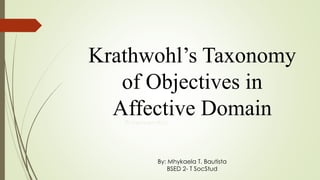Contenu connexe Similaire à Krathwohl's Taxonomy of Affective Domain (20) 3. David Reading Krathwohl (born May 14, 1921) is
an American educational psychologist who has served education in a
multitude of settings: he was the director of the Bureau of Educational
Research at Michigan State University and was also a past president of the
American Educational Research Association where he served in multiple
capacities, as a member of the research advisory committee for the Bureau
of Research of the USOE and as regional chairman of the board of trusties
of the Eastern Regional Institute for Education. While studying
with Benjamin Bloom, he co-authored the Taxonomy of Educational
Objectives, (also known as Bloom's Taxonomy) a critical publication on
education and has also edited, authored and co-authored several books in
regards to education. He received the Hannah Hammond Professor of
Education Emeritus at Syracuse University and has made significant
contributions to the field of educational psychology.
© menuemitch
6. Demonstrated by behaviors indicating attitudes of awareness, interest,
attention, concern, and responsibility, ability
to listen and respond in interactions with others, and ability to
demonstrate those attitudinal characteristics or values which are
appropriate to the test situation and the field of study.
© menuemitch
8. It refers to the student's willingness to attend to particular
phenomena of stimuli (classroom activities, textbook, music,
etc.). Learning outcomes in this area range from the simple
awareness that a thing exists to selective attention on the part
of the learner. Receiving represents the lowest level of
learning outcomes in the affective domain.
© menuemitch
9. Examples:
Listening to discussions of controversial issues with an
open mind.
Respecting the rights of others.
Listen for and remember the name of newly introduced
people.
© menuemitch
11. Refers to active participation on the part of the student.
At this level he or she not only attends to a particular
phenomenon but also reacts to it in some way. Learning
outcomes in this area may emphasize acquiescence in
responding (reads assigned material), willingness to respond
(voluntarily reads beyond assignment), or satisfaction in
responding (reads for pleasure or enjoyment). The higher
levels of this category include those instructional objectives
that are commonly classified under “interest”; that is, those
that stress the seeking out and enjoyment of particular
activities.
© menuemitch
12. Examples:
Completing homework assignments.
Participating in team problem solving activities.
Questions new ideals, concepts, models, etc. in order to
fully
understand them.
© menuemitch
14. It is concerned with the worth or value a student attaches to a
particular object, phenomenon, or behaviour. This ranges in
degree from the simpler acceptance of a value (desires to
improve group skills) to the more complex level of commitment
(assumes responsibility for the effective functioning of the
group). Valuing is based on the internalization of a set of
specified values, but clues to these values are expressed in the
student's overt behavior. Learning outcomes in this area are
concerned with behavior that is consistent and stable enough to
make the value clearly identifiable. Instructional objectives that
are commonly classified under “attitudes” and “appreciation”
would fall into this category.
© menuemitch
15. Examples:
Accepting the idea that integrated curricula is a good
way to learn.
Participating in a campus blood drive.
Demonstrates belief in the democratic process.
Shows the ability to solve problems.
Informs management on matters that one feels
strongly about.
17. It is concerned with bringing together different values,
resolving conflicts between them, and beginning the building
of an internally consistent value system. Thus the emphasis is
on comparing, relating, and synthesizing values. Learning
outcomes may be concerned with the conceptualization
of a value (recognizes the responsibility of each individual
for improving human relations) or with the organization of a
value system (develops a vocational plan that satisfies his or
her need for both economic security and social service).
Instructional objectives relating to the development of a
philosophy of life would fall into this category.
© menuemitch
18. Examples:
Recognizing own abilities, limitations, and values and
developing realistic aspirations.
Accepts responsibility fro one’s behaviour.
Explains the role of systematic planning in solving
problems.
Accepts professional ethical standards.
Prioritizes time effectively to meet the needs of the
organization, family, and self.
© menuemitch
20. The individual has a value system that has controlled his or her
behaviour for a sufficiently long time for him or her to develop
a characteristic “life-style.” Thus the behaviour is pervasive,
consistent, and predictable. Learning outcomes at this level
cover a broad range of activities, but the major emphasis is on
the fact that the behaviour is typical or characteristic of the
student. Instructional objectives that are concerned with the
student's general patterns of adjustment (personal, social,
emotional) would be appropriate here.
© menuemitch
21. Examples:
A person's lifestyle influences reactions to many different
kinds of
situations.
Shows self-reliance when working independently.
Uses an objective approach in problem solving.
Displays a professional commitment to ethical practice on a
daily basis.
Revises judgments and changes behaviour in light of new
evidence.
© menuemitch

